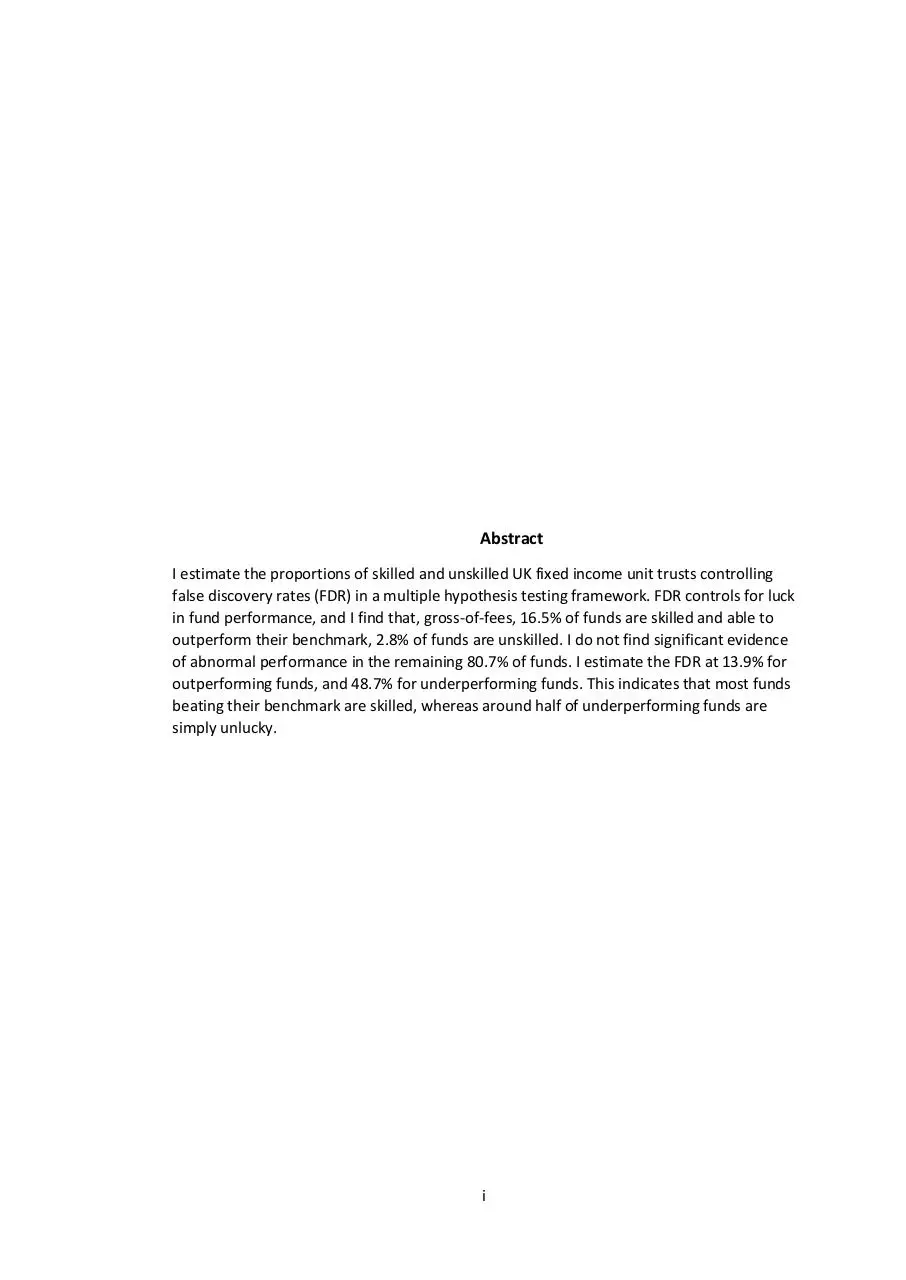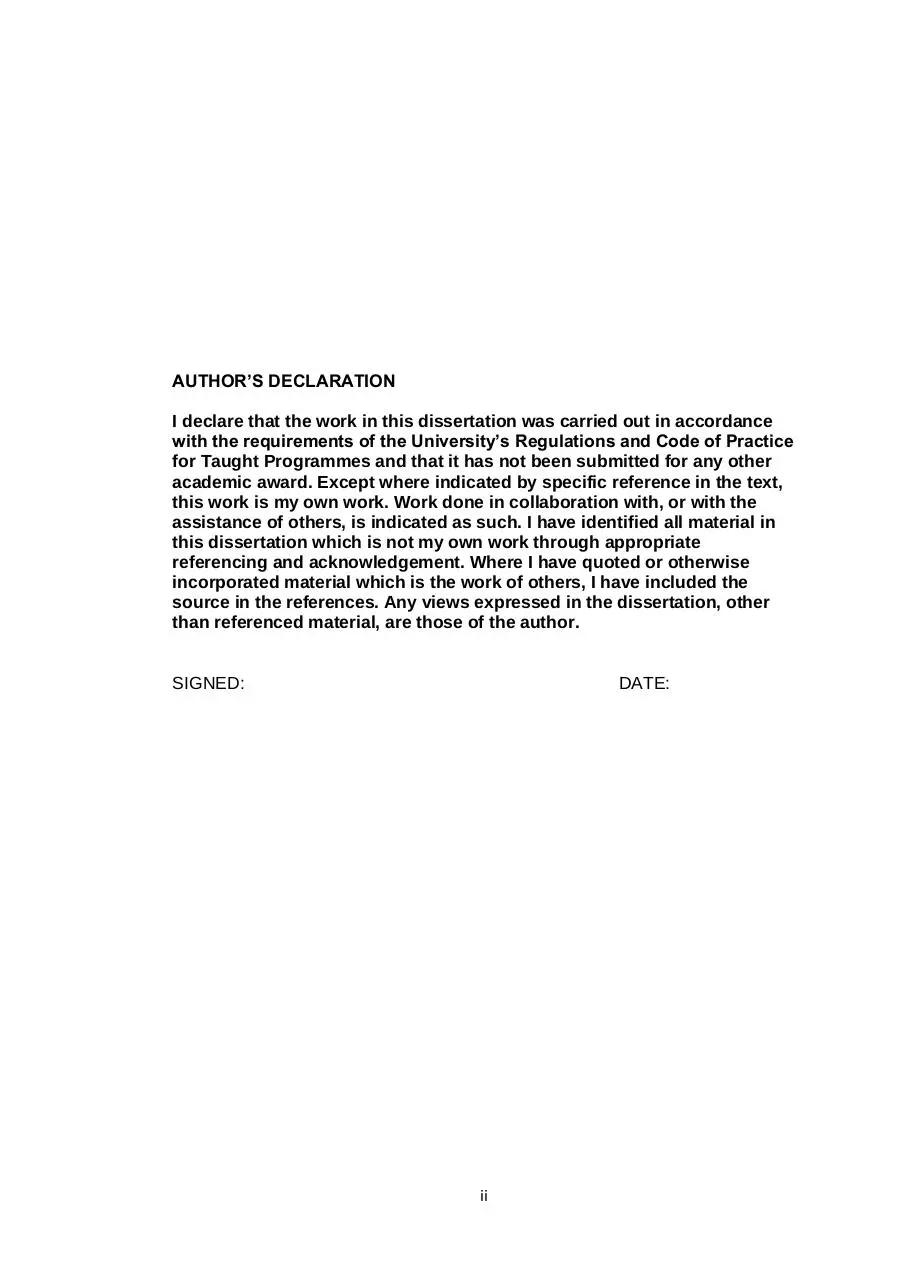Tom Platonoff 1113920 Dissertation 2015 (PDF)
File information
Author: T Platonoff
This PDF 1.5 document has been generated by Microsoft® Word 2013, and has been sent on pdf-archive.com on 10/02/2016 at 12:46, from IP address 151.225.x.x.
The current document download page has been viewed 625 times.
File size: 1.05 MB (65 pages).
Privacy: public file





File preview
False Discovery Rates:
Separating Skill from Luck in UK Unit Trust Performance
Tom Platonoff
A dissertation submitted to the University of Bristol in accordance with the
requirements of the degree of Master of Science by advanced study in
Economics and Finance in the Faculty of Economics, Finance and Management.
University of Bristol, School of Economics, Finance, and Management
7th of September 2015
Student Number: 1113920
Word Count: 16,481
Abstract
I estimate the proportions of skilled and unskilled UK fixed income unit trusts controlling
false discovery rates (FDR) in a multiple hypothesis testing framework. FDR controls for luck
in fund performance, and I find that, gross-of-fees, 16.5% of funds are skilled and able to
outperform their benchmark, 2.8% of funds are unskilled. I do not find significant evidence
of abnormal performance in the remaining 80.7% of funds. I estimate the FDR at 13.9% for
outperforming funds, and 48.7% for underperforming funds. This indicates that most funds
beating their benchmark are skilled, whereas around half of underperforming funds are
simply unlucky.
i
AUTHOR’S DECLARATION
I declare that the work in this dissertation was carried out in accordance
with the requirements of the University’s Regulations and Code of Practice
for Taught Programmes and that it has not been submitted for any other
academic award. Except where indicated by specific reference in the text,
this work is my own work. Work done in collaboration with, or with the
assistance of others, is indicated as such. I have identified all material in
this dissertation which is not my own work through appropriate
referencing and acknowledgement. Where I have quoted or otherwise
incorporated material which is the work of others, I have included the
source in the references. Any views expressed in the dissertation, other
than referenced material, are those of the author.
SIGNED:
DATE:
ii
Table of Contents
List of Tables ........................................................................................................................... vi
List of Figures .......................................................................................................................... vi
1. Introduction ......................................................................................................................... 1
1.1 Overview of procedure .................................................................................................. 2
1.2 Organisation of paper .................................................................................................... 4
2. Luck in Fund Performance................................................................................................... 4
2.1 The impact of luck in fund performance studies ........................................................... 5
2.2 Hypothesis testing.......................................................................................................... 5
2.2.1 The multiple testing problem: false discoveries .................................................... 6
2.3 Type one error control procedures ................................................................................ 8
2.3.1 Barras Scaillet Wermers (BSW) false discovery rate procedure ............................ 8
2.3.2 Family wise error rates and the Bonferroni procedure .......................................... 8
2.2.3 Benjamini-Hochberg false discovery rate procedure ............................................. 9
2.4 Properties and advantages of the BSW procedure ...................................................... 10
2.2.3 Power .................................................................................................................... 10
2.2.3 Scalability and adaptivity ...................................................................................... 10
2.2.3 Bayesian interpretation ........................................................................................ 11
2.5 Methodological difficulties and limitations ................................................................. 12
2.5.1 Independence and normality assumptions .......................................................... 12
2.5.2 Estimating the true proportion of true nulls ........................................................ 13
2.5.3 Bootstrapping as a solution .................................................................................. 15
2.5.3 Serial correlation and heteroskedasticity ............................................................. 16
3. Performance Measurement .............................................................................................. 16
3.1 Linear factor models .................................................................................................... 17
3.1.1 CAPM single index, Fama French 3 factor, and Carhart 4 factor models ............. 17
3.1.2 Capturing market timing: Treynor-Mazuy Model ................................................. 18
3.2 Model motivation, literature, considerations .............................................................. 18
3.1 Factor model critiques ................................................................................................. 19
iii
4. Data.................................................................................................................................... 20
4.1 Market data.................................................................................................................. 21
4.2 Fund data ..................................................................................................................... 21
4.2.1 Restrictions and homogeneity considerations ..................................................... 22
4.2.3 Survivor bias .......................................................................................................... 23
4.2.3 Minimum history bias ........................................................................................... 25
4.2.4 Data shortfalls: managerial changes; fund misclassification; conditional variables
....................................................................................................................................... 25
5. Empirical Strategy and Results ......................................................................................... 26
5.1 Estimation procedure and key results ......................................................................... 26
5.2 Cross-sectional regression results ................................................................................ 27
5.3 BSW false discovery rate procedure ............................................................................ 31
5.3.1 P value distribution and estimating 𝜋0 ................................................................. 31
5.3.2 Population proportion and false discovery rate results ....................................... 32
5.3.3 Examination of tail distributions .......................................................................... 33
5.3.4 Bayesian interpretation ........................................................................................ 34
5.3.5 Asymptotic adjustment of P distribution ............................................................. 35
5.4 Comparison of type one error control procedures ...................................................... 36
6. Comparison with existing literature ................................................................................. 37
6.1 Multiple hypothesis testing literature using false discovery rates .............................. 37
6.1.1 UK .......................................................................................................................... 37
6.1.2 Other developed markets ..................................................................................... 38
6.1.3 Developing markets .............................................................................................. 39
6.2 Multiple hypothesis testing literature using cross-sectional bootstraps..................... 39
6.2.1 UK .......................................................................................................................... 39
6.2.2 US .......................................................................................................................... 40
6.3 Other UK fund performance studies ............................................................................ 41
7. Discussion .......................................................................................................................... 44
7.1 UK Unit Trusts .............................................................................................................. 44
7.2 Practical implications of results ................................................................................... 45
7.3 Theoretical implications and explanations .................................................................. 46
iv
7.3.1 Efficient Market Hypothesis.................................................................................. 46
7.3.2 Berk and Green Equilibrium (2004) ...................................................................... 47
8. Conclusion ......................................................................................................................... 48
Bibliography........................................................................................................................... 50
Appendix ................................................................................................................................ 55
v
List of Tables
Table 1: Possible outcomes from m hypothesis tests.............................................................. 7
Table 2: BSW false discovery rate procedure results ............................................................ 27
Table 3: Cross-sectional regression summary statistics of UK Unit Trusts ............................ 29
Table 4: Comparison of false discovery rates at different significance levels ....................... 33
Table 5: Comparative results of hypothesis testing procedures .......................................... 37
Table 6: Comparative results of type one error control procedures .................................... 26
Table 7. Comparison of existing fund performance literature ...................................... 42 – 43
Table A1: Estimating 𝜋̂0 ........................................................................................................ 56
List of Figures
Figure 1. Distribution of returns from funds satisfying a null and alternative hypothesis ...... 6
Figure. 2: Distribution of fund alphas .................................................................................... 30
Figure. 3: Distribution of p values .......................................................................................... 32
Figure. 4: Asymptotic distribution of p values ....................................................................... 35
Figure. 5: Active and passive assets as a proportion of total UK assets under management
(2006 – 2013) ......................................................................................................................... 26
Figure. A1: Alternative model distribution of p values .......................................................... 55
Figure. A2: Estimating 𝜋̂0 ...................................................................................................... 56
Figure. A3: Sum of Squared errors of 𝜋̂0 (𝜆) .......................................................................... 57
vi
1. Introduction
Unit Trusts (UTs) are a major institution in the UK financial industry, managing over £770bn
in assets in December 2013. UTs are one of three sets of financial institutions in the UK
(investment trusts and open-ended investment companies (OEICs) are the other two). UTs
allow participants to buy and sell units/shares of a diversified portfolio of marketable
securities, with no major restrictions on withdrawing capital invested, unlike, for example,
pension funds, which are similar in most characteristics other than their illiquid nature.
Approximately 80% of UK funds are actively managed whereby managers are entrusted to
pick the portfolio of securities. Evaluating the performance of actively managed funds is
important to investors, who pay for the stock picking services of fund managers. The
existence of abnormal performance is also important from a theoretical perspective testing
the validity of the Efficient Market Hypothesis. A substantial body of empirical work exists
assessing the performance of managed funds, although heavily weighted towards US
studies, and relatively little towards the UK market.
Early works such as Jensen (1968) found that US fund managers demonstrate little or no
stock picking abilities to deliver returns greater than a passive market index portfolio,
especially net of management fees. More recent studies have found a wide range of results
with more sophisticated analysis: Carpenter and Lynch (1999) claim that:
‘in general, empirical studies find that mutual fund performance is persistent’ ;
Whereas Bessler, Blake, Luckoff and Tonks (2010) inform the reader that:
‘it is widely recognised that equity mutual fund performance does not persist in the long
term’.
Cross-sectional mean returns cast an unfavourable (or at least an uncertain) light on the
value of active management, however the cross-sectional standard deviation of abnormal
returns is high. This could indicate volatile returns around a zero mean, or that certain
funds are consistently outperforming or underperforming the market benchmark.
Individual investment decisions are revealing, and investors appear confident that they can
identify outperforming actively managed funds.
1
In a fund universe where there exist unobservable proportions of skilled (positive abnormal
performance), unskilled (negative abnormal performance), and funds that match the
market, a cross-sectional average of returns will not tell us whether or not skilled or
unskilled funds exist. It will just tell us what fund returns are on average. For this reason we
require multiple hypothesis testing procedures. These are procedures which test each fund
individually against a null hypothesis of no abnormal performance. However, multiple
hypothesis testing procedures generate a certain proportion of type one errors, where the
null hypothesis is incorrectly rejected, and we could say that the fund manager was simply
lucky (or unlucky) in the testing period. These are false discoveries. I investigate methods to
control the type one error rate..
I examine the cross-sectional distribution of abnormal returns, and using a method known
as the false discovery rate (FDR), separate the truly skilled (unskilled) funds from those
which have produced positive (negative) returns through sheer good (bad) luck.
I find significant evidence for the existence of non-zero minorities of outperforming and
underperforming UK unit trusts between 1980 and 2014. Gross of fees, I find that 80.7% of
funds do not exhibit significant abnormal returns, 16.5% are skilled, 2.8% are truly
unskilled. Funds outperform the market by a cross-sectional average of approximately 0.2%
per month, depending on the performance model used. As in other literature, there is
substantial variation in performance.
I find that 13.9% of funds identified as outperformers by standard testing procedures are
lucky rather than skilful, and that 48.7% of the small number of underperformers are
unlucky. Contrary to net-of-fee literature, these findings show that before fees, very few
fund managers underperform benchmarks due to a lack of skill, and a practically and
statistically significant number outperform the market with skill.
1.1 Overview of procedure
To estimate the proportion of outperforming and underperforming funds, we must first
estimate benchmark returns, then estimate the proportion of funds outperforming and
underperforming the benchmark. Though simple in concept, this procedure contains
numerous empirical difficulties, I attempt to address as many as possible within the
constraints of this project. The main issue addressed in this paper is that of controlling the
type one error rate.
2
Download Tom Platonoff 1113920 Dissertation 2015
Tom Platonoff 1113920 Dissertation 2015.pdf (PDF, 1.05 MB)
Download PDF
Share this file on social networks
Link to this page
Permanent link
Use the permanent link to the download page to share your document on Facebook, Twitter, LinkedIn, or directly with a contact by e-Mail, Messenger, Whatsapp, Line..
Short link
Use the short link to share your document on Twitter or by text message (SMS)
HTML Code
Copy the following HTML code to share your document on a Website or Blog
QR Code to this page

This file has been shared publicly by a user of PDF Archive.
Document ID: 0000338961.